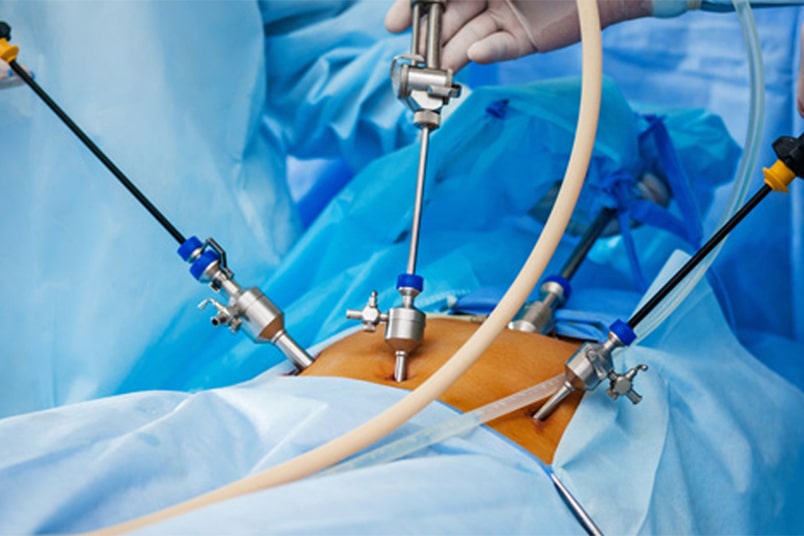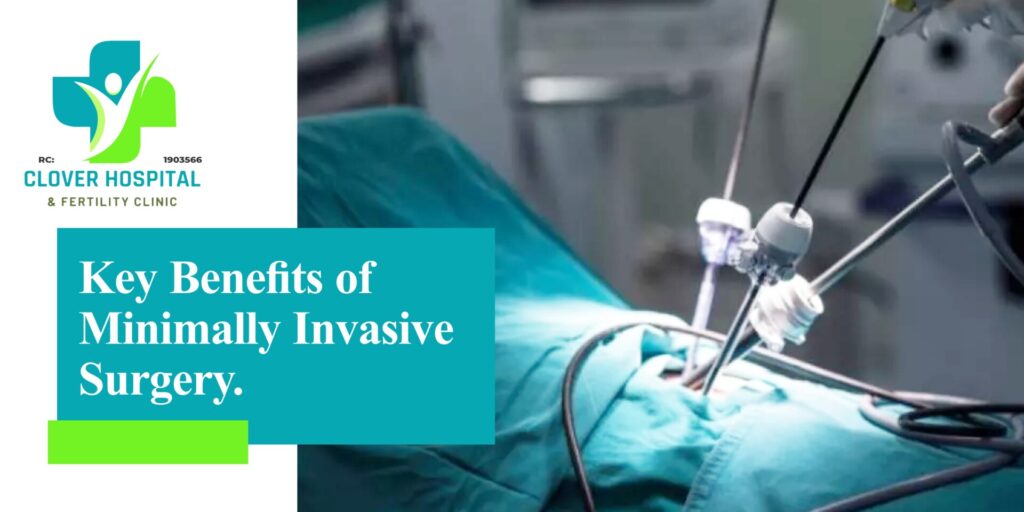Non-Invasive Surgeries
Home / Non-Invasive Surgeries

Minimally invasive surgery, also known as laparoscopic or keyhole surgery, is a modern surgical technique that allows doctors to perform complex procedures through tiny incisions, typically less than an inch long. This approach offers numerous benefits compared to traditional open surgery, including less tissue damage, reduced scarring, and faster recovery times.
Types of Minimally Invasive Surgery
- Laparoscopic Surgery: Laparoscopic surgery is a minimally invasive technique that uses small incisions, typically less than an inch long, to access the surgical site to perform abdominal and pelvic surgeries. The surgeon inserts a thin, lighted camera called a laparoscope through one of the incisions, allowing them to view the procedure on a monitor and guide the surgical instruments with precision.
-
Upper and Lower GI Endoscopy: At Clover Hospital, Upper and Lower GI Endoscopy procedures are used to diagnose and treat conditions within the gastrointestinal tract. Upper GI Endoscopy involves inserting a thin, flexible tube with a camera (endoscope) through the mouth to examine the oesophagus, stomach, and upper small intestine. It helps detect issues like ulcers, acid reflux, or abnormal growths. Lower GI Endoscopy (colonoscopy or sigmoidoscopy) involves examining the rectum and colon by inserting the endoscope through the anus. This procedure is crucial for detecting polyps, inflammation, and signs of colorectal cancer. Both procedures are minimally invasive, offering valuable insights for accurate diagnosis and effective treatment.
3. Cystoscopy: Cystoscopy at Clover Hospital is a minimally invasive procedure used to examine the inside of the bladder and urethra. A thin, flexible tube with a camera (cystoscope) is gently inserted through the urethra into the bladder. This procedure is essential for diagnosing and treating urinary tract issues, such as bladder stones, infections, and abnormal growths. Cystoscopy also allows for the removal of small bladder stones or tissue samples for biopsy. It’s a key tool in managing urological health, providing patients with accurate diagnoses and targeted treatment options.
Who is a candidate for minimally invasive surgery?
Candidates for minimally invasive surgery are typically in good overall health, able to tolerate anaesthesia, and have suitable anatomy for the specific technique. Common conditions treated include gallbladder problems, hernias, joint issues, gynaecological conditions, and certain cancers. A thorough evaluation by a surgeon is necessary to determine suitability.
What Happens During Minimally Invasive Surgery?
1. Pre-Op Preparation:
Before the procedure, patients will receive detailed instructions from their surgeon on how to prepare. This may include fasting, stopping certain medications, and completing any necessary diagnostic tests.
2. Anaesthesia and Incisions:
During the surgery, the patient will be given general anaesthesia or a local anaesthetic with sedation. The surgeon will then make small incisions, typically less than an inch long, to access the treatment area.
3. Surgical Instruments:
The surgeon will insert specialised surgical instruments through the small incisions, including a tiny camera called a laparoscope or endoscope. These tools allow the surgeon to visualise the treatment area and perform the procedure with precision.
4. Recovery and Aftercare:
After the surgery, patients usually experience less pain and a faster recovery time compared to traditional open surgery. They will receive instructions for post-operative care and may be able to return to normal activities sooner.
Key Benefits of Minimally Invasive Surgery
- Reduced Pain and Discomfort: Because minimally invasive procedures only require small incisions, patients experience significantly less postoperative pain and discomfort compared to traditional open surgery. This leads to a more comfortable recovery process.
- Small incisions Instead of a large incision, the surgeon makes just a few small cuts, typically less than an inch long. This minimises tissue damage and scarring.
- Camera Guidance: The surgeon inserts a tiny camera called an endoscope through one of the incisions. This allows them to see the surgical area on a monitor and guide the surgical tools precisely.
- Shorter hospital stays Many patients undergoing minimally invasive surgery are able to be discharged from the hospital on the same day or within a day or two, much faster than the multi-day hospital stays common with open procedures.
- Faster Recovery: Patients often experience less pain, less blood loss, and a quicker return to normal activities after minimally invasive surgery compared to open procedures.
- Advanced Techniques: Minimally invasive surgeries use specialised tools and techniques to access the surgical site through small incisions rather than large open incisions.
- Improved Outcomes: This approach can lead to reduced pain, scarring, and recovery time for patients compared to traditional open surgery.
- Reduced Risks of Complications: Smaller incisions mean less tissue trauma, blood loss, and the risk of infection or complications.
- Better cosmetic outcomes: minimally invasive techniques result in smaller, less noticeable scars, providing a better cosmetic outcome for the patient.
Need Laparoscopy or Endoscopy?
Minimally invasive procedures generally result in quicker recovery times and less post-operative pain.


Available 24 Hours
+2349062033554
Clover Services
07Sep
September 07, 2024
Tips for a Healthy pregnancy
Read More
01Sep
September 01, 2024
Understanding the different types of assisted reproductive technology
Read More
07Aug
August 07, 2024
Key Benefits of minimally Invasive Surgery
Read More
Book Your Appointment Now
Comprehensive care with expert doctors, advanced technology, and a wide range of specialised services, from gynaecology to emergency response—your health is our priority.
Book Appointment
Contact Us Now



